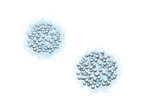CBM - Inside a neutron star
The collision of atomic nuclei at high speeds can simulate the conditions inside supermassive objects for a split second.

When a massive star reaches the end of its life, it explodes as a huge supernova, leaving behind an incredibly dense central core — a neutron star. Although it is only the diameter of a city, it weighs around one million times more than the whole Earth! Scientists are planning to use the CBM (Compressed Baryonic Matter) experiment to find out how matter changes at such densities. They want to know, for example, if all of the matter breaks down into its elementary particles — quarks and gluons — to create a ‘quark–gluon’ plasma, as is thought to have existed shortly after the Big Bang.
States of matter — the different forms of matter
In everyday life, matter can exist in either solid, liquid or gaseous states. Experience has shown that these states depend on the temperature. Water, for example, is a solid at 0°C and below; it is a liquid between 0 and 100°C, and then boils at 100°C to become a gas at higher temperatures.
However, the state of the matter in question depends not only on the temperature but also on the pressure and thus its density. At an altitude of about 3,000 metres, for example, water boils at 90°C because the air pressure is lower than at sea level. It is thus important to know the state of a substance at a particular temperature and density because this information gives us a deep understanding of its building blocks and the forces acting within its interior.


Inside the fireball
The densities inside a neutron star far exceeds anything found here on Earth; we know that the positively charged protons and the negatively charged electrons composing atoms are literally crushed together to form neutral neutrons (thus the name). However, nobody knows what happens right at the star’s core where the density is highest. Do the neutrons dissolve into a kind of super-dense ‘elementary particle soup’ of freely moving quarks and gluons, as predicted by physical models?
This theory can be tested with the CBM experiment, which will create such highly compact matter on a tiny scale. To do this, scientists will make two heavy nuclei collide with high energy so that they are pressed together to form an extremely dense ‘fireball’. It will be too fleeting to be studied directly, but the subsequent explosion can be observed.




It will create up to 1,000 new particles, most of them very ephemeral. Some of these particles will immediately decay into pairs of electrons and their antiparticles, positrons, while others will split into pairs of muons, a kind of heavy electron. CBM will focus specifically on these particles, because they are direct messengers from the expanding fireball region and are not affected by the strong interaction (the fundamental force holding together the quarks making up the protons and neutrons in nuclei). This will enable scientists to determine how nuclear matter behaves at extremely high densities such as those found in neutron stars.

